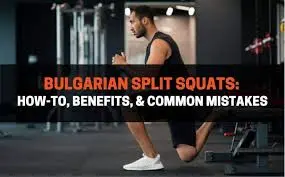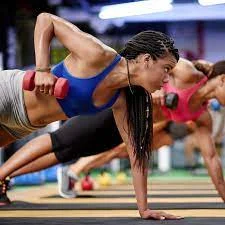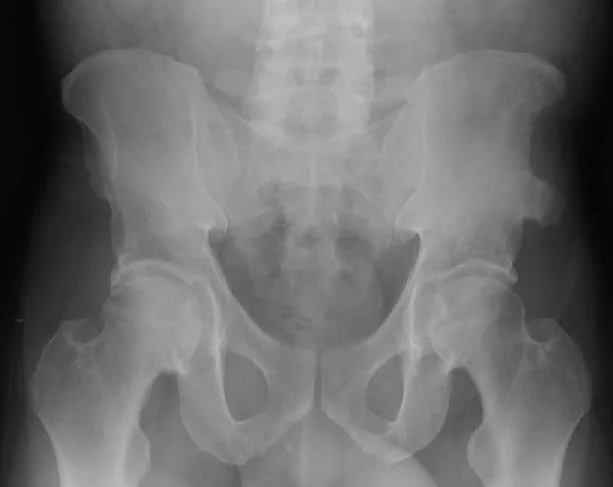Bulgarian Split Squat Exercise
What is a Bulgarian Split Squat?
Elevating the rear leg during a split squat is known as a Bulgarian split squat. You may also think of it as a single-leg squat variant. A conventional single-leg squat involves balancing on the weighted leg and lowering yourself onto your stabilizing leg in front of your body.
The balance leg moves behind your torso when performing a Bulgarian split squat. It stays lifted throughout the exercise, much as in a single-leg squat, but it doesn’t just hang there. Rather, it lies flat on a seat, strap, or similar surface.
What Muscles Do Bulgarian Split Squats Work?
Similar to other complex lower body exercises, the Bulgarian split squat simultaneously engages many muscles:
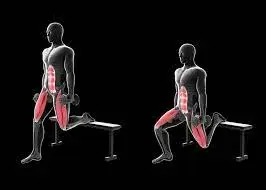
- Fours
- Glutes
- Hamstrings
- Calves
Core: consisting of the spinal erectors and abdominals
Compared to standard squats, the split squat positions the quadriceps under more strain. You may transfer part of the weight to your glute muscles by positioning your forward foot and squatting deeply.
Better glutes are frequently the top priority for clients, whether it’s for form, function, or figure.
How to perform a Bulgarian split squat?
- A Bulgarian split squat requires a bench or sturdy chair. Dumbbells or kettlebells can provide more resistance as your muscle memory for the activity improves. Place yourself around two feet in front of a seat or step that is knee-level to start.
- Raise your right leg to its maximum length on the stool behind you. In order to make a rapid lunge, your right foot still has to be around shoulder-width apart and far enough in front of the bench or chair. You can bounce around a bit to achieve the perfect position. If a closer foot position works, make sure your left knee does not overlap your toes when you descend.
- Lower yourself onto your left leg, bending the knee, while rolling your shoulders back, slanting slightly at the waist, and contracting your core.
- If you are executing a quad-dominant Bulgarian split squat, stop before your knee touches your toes. Your left thigh should be parallel to the floor when you stop using your glutes in a Bulgarian split squat.
- Use the strength in your hamstrings and quadriceps to push up with your left foot and re-stand.
- After completing the required number of reps on this leg, place your left foot back on the bench.
Other Variations of Bulgarian Split Squats
Here are several options on how to perform a split squat without using a bench or how to make it more difficult by adding weight.
- Split Squat:
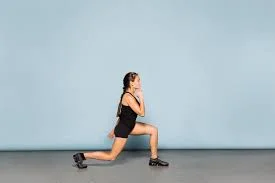
- Despite their frequent interchangeability, the terms “split squat” and “Bulgarian split squat” refer to two distinct forms of the exercise. The split squat is executed without the back leg lifted, but the Bulgarian split squat is executed with the back leg elevated on a bench or solid chair.
- Recall that this is not the same as a lunge, in which the exercise also uses the rear leg.
- Follow the same instructions, but place your back foot on the ground.
- While your front leg should sustain the whole movement, you can use your rear leg to aid with balance.
- Bulgarian Split Squat with Weights:
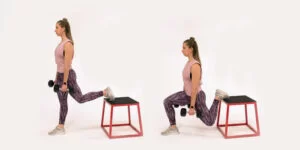
- Add weights to the exercise once you’ve acquired the right technique to increase difficulty.
- To increase the difficulty of the workout, hold a pair of dumbbells or kettlebells in your hands.
- Before beginning the Bulgarian split squat, lay an empty or loaded barbell over your shoulders for an even more difficult version.
- Zercher Bulgarian Split Squat:

- When performing a Zercher Bulgarian split squat, you press a weighted barbell up against your chest. This increases the squat’s core activation. You use your quadriceps and upper back to balance between the weight in front of you and the leg behind you.
- Exercise ball: Bulgarian split squat:
- A proper Bulgarian split squat requires balance and proper leg separation. Thus, if you truly want to increase the challenge, make striking that balance more difficult.
- It is more difficult to use your rear leg for support when you squat with it rested on an exercise ball. During a Bulgarian split squat, your dangling back leg provides substantial additional balance and stability.
- Eccentric Bulgarian split squat:
- You want to drop down as slowly as possible in this extremely difficult variation to maximise activation. Your legs get more tense as a result, and you become more aware of your form. Once you’ve mastered it, the outcomes ought to be self-evident.
Which is preferable, Bulgarian split squats or lunges?
Although there is no one workout that is better than another, depending on your objectives and experience, there may be one that is a better fit for you than others. For example, you might want to put off Bulgarian split squats until you can do lunge variants with good form if you’re new to exercising and unsure about whether to execute a split squat or a lunge.
Let’s take a brief diversion: Lunges are an additional workout for the lower body that entails lowering your body until your legs make a 90-degree angle on both sides by stepping one foot forward (front lunge)/ back (reverse lunge).
Since the Bulgarian split squat is a lunge’s progression, Summers adds that depending on an individual’s strength and ability, she would suggest either exercise.
According to Summers, you should only do Bulgarian split squats after you have been proficient in standard split squats, step-ups, front or back lunges, and even walking lunges. Before adding additional stability & range of motion components, we must master the skills of lunging & squatting with both foot on the floor.
On the other hand, the Bulgarian split squat is a fantastic addition to your lower-body exercises if you’re a more experienced exerciser who has previously mastered those movements and your objective is to develop single-leg strength and enhance balance while increasing load.
An example of a Bulgarian split squat strength workout
Finish all four sets of each block, then switch between the two workouts. Every three to five minutes, take a break.
Start with a dynamic warm-up and preparation for the motions, including band exercises, PVC warm-ups, or dynamic lower body movements.
- A. Back Squat with a Barbell: 4 sets of 5 reps
- A. Dips: 6 repetitions per arm, 4 sets
- B. Barbell Deadlift: 5 repetitions in 4 sets
- B. 4 sets of 6 repetitions for pull-ups
- C. Bulgarian Split Squat: 6 repetitions per leg, 4 sets
- C. Inclined Dumbbell Press: 5 repetitions in 4 sets.
Finish with static stretches targeting the muscles of the upper back, shoulders, and lower body.
What dangers come with performing split squats in Bulgarian?
In general, intermediate fitness enthusiasts may safely do Bulgarian split squats. But if you’re new to working out, you might want to attempt a simpler version. This workout calls for a fair degree of balance, lower body strength, and coordination.
The following advice will help you complete this activity safely:
- Get warmed up: Stretch out your lower body well before beginning these squats.
- Retain the correct form. Ineffective form can reduce the effectiveness of your workout and raise your risk of injury.
- Regain your balance. Place your feet as carefully as possible. Recall that balance and good alignment are key to doing this squat correctly.
- Treat your knees with care. If you have a history of knee problems, you might want to stay away from Bulgarian split squats. Squats that are too deep might strain your joints.
- Keep yourself within your bounds. These squats might be challenging, particularly for first-timers. Hence, be sure you gradually increase the number of repetitions and sets you perform.
What are some alternatives to the Bulgarian split squat?
There are many other exercises that have comparable effects, whether you want to keep your workouts interesting and enjoyable or you simply don’t feel comfortable performing Bulgarian split squats. These are five that you may do at the gym or at home.
- Classic squat
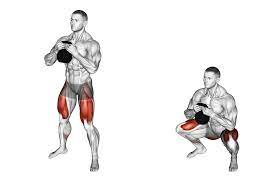
- It’s OK to return to the fundamentals when working towards a more complex manoeuvre.
- For the classic squat:
- Ensure that your feet are shoulder-width apart.
- Turn your feet roughly ten degrees outward. You should continue to place your heels on the ground. Maintain an open chest, shoulders back, and neutral spine.
- Leading with your hips, descend into a squat as though you’re ready to take a seat.
- Maintaining a neutral spine, bend as much as you can. Make an effort to align your thighs with the floor.
- To go back to where you were before, push through your heel.
- Repeat.
- P.S. You can put your hands on your hips, extend your arms straight in front of you, or clasp them in front of you with your elbows slightly bent.
- The Pistol squat
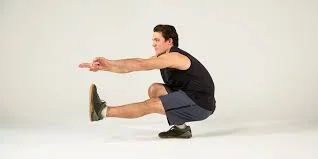
- This one-leg squat improves strength, mobility, and balance.
- Perform a pistol squat by:
- Place your arms out in front of you and your feet together.
- As you descend into the squat on your right leg, lift and maintain the straightness of your left leg.
- Drop your left leg until it is parallel to the ground.
- To go back to the beginning position, drive through your right heel. Then, repeat with the opposite leg.
- Just so you know, you can intensify your pistol squats by including a dumbbell.
- The sidekick squat

- Adding a kick to a squat strengthens your lower body and increases your heart rate.
- Sidekick squat technique:
- Enter a typical squat position.
- Utilise your heels to propel yourself back up.
- Step into a standing stance and extend your right leg as far as possible.
- Before you perform your next squat, make sure your kicking leg is back in the right place.
- Kick with the opposite leg and repeat.
- The curtsy squat
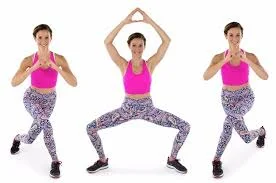
- When you’re in the middle of a workout, has the Queen of England ever entered the gym? For you, we have the ideal workout, though! Not only is the curtsy squat courteous to Her Majesty, but it also works your glutes.
- To squat with a curtsy:
- With your hands on your hips, take a shoulder-width stance with your feet apart.
- Step your right leg back and cross it behind your left leg to squat with your left leg.
- Reduce until your left leg is in line with the floor.
- Put pressure on your left heel to get back to the beginning position.
- Continue on the opposite side.
- Squat jump
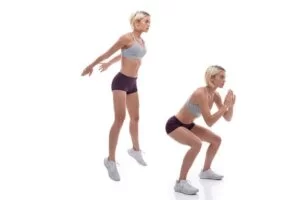
- A jump squat puts your leg’s explosive strength and coordination to the test.
- Jump-squat technique:
- Ensure that your feet are shoulder-width apart.
- Put your feet about ten degrees out from the body. You should continue to place your heels on the ground. Maintain an open chest, shoulders back, and neutral spine.
- Leading with your hips, descend into a squat as though you’re ready to take a seat.
- Lean forward and extend your legs.
- Return your feet to the starting position and land gently.
- Repeat.
Ten advantages of Bulgarian split squats
These are the top 10 advantages of Bulgarian split squats that you should be aware of.
Determine and fix imbalances in your muscles from left to right:
The majority of people frequently have stronger sides than others. However, excessive strength disparities might result in mishaps and even back pain. By performing Bulgarian split squats, you will identify and address any left-to-right strength imbalances.
Become more balanced:
It is balanced to be able to keep your centre of mass over your base of support. On the other hand, your capacity for exercises that include straight bilateral movements will only serve to improve balance, which often declines with age. Exercises that test and enhance balance include Bulgarian split squats.
Increasing hip flexor suppleness:
The Bulgarian split squat allows for a broad range of motion in the hips and knees. It is feasible to lessen muscular tension and increase hip mobility and flexibility by increasing the range of motion. Split squats are like doing a moving yoga pose.
Lessen the strain on your lower back:
When using one leg at a time, you do not need to use as much weight as you would for squats and leg presses. When you are lighter, split squats with the rear foot elevated are much easier on your lower back. A lot of exercises discover that their own weight is adequate to give good workouts.
Good for your glutes:
If you adopt a wide stance, Bulgarian split squats are ideal for building strength, toning, and height in your buttocks. Your booty will look better after doing this workout. To make it even more butt-centric, place your front foot on a 3-6″ platform. You’ll be able to press your buttocks harder and enter a split squat thanks to this small elevation.
Improve your running ability:
Regularly executing Bulgarian split squat exercises has two benefits: it strengthens your leg muscles and makes you run faster. Thus, you need to incorporate this into your training routine if you’re an athlete or wish to run faster.
Increase your strength and muscular mass:
Split squats are a great way to build muscle and develop your legs while working out. You will gain more muscle and single-leg strength the more you train. This workout will become even more challenging and beneficial if you do it with weights.
Fantastic for reducing fat:
Because Bulgarian split squats use so many strong muscles, they are calorie-burning exercises. Additionally, you will breathe and pulse more quickly, which will help you burn fat and lose weight.
A single exercise for lower body training:
Because they train so many different muscles, rearfoot-raised split-leg squats could be the only leg exercise you ever need to do. If you’re short on time, the Bulgarian split squat is an excellent lower-body workout that you can do all at once.
Do them anywhere, anytime:
You can do a Bulgarian split squat anywhere, at any time, without any particular equipment. All you need is some space and a platform that fits your back foot. You can get by with a bed or a strong chair instead of an exercise bench.
Which errors should you avoid the most frequently?
Anybody can make mistakes when doing the Bulgarian split squats because it’s normal to make mistakes when you’re just starting out or don’t have a trainer.
Putting the rear leg in front of the front
If your rear foot is directly behind your front foot, it will be difficult for you to maintain balance. Since your front leg initiates the action and your front foot provide most of the support during a squat, maintaining your balance is a problem with unilateral balancing alone. As you place your back foot on the seat behind you, make sure it is approximately hip distance apart from your front foot. Even if you aren’t utilizing your back foot or leg to push the activity, you may still perform the Bulgarian split squat with the assistance of this broader “kickstand.”
Putting too much forward hip flexion
When doing the Bulgarian split squat downhill, it’s easy to lose attention to your core, namely your abdominals and spinal erectors. This forward lean diminishes the primary advantages of the exercise and raises the risk of overstressing your front knee by shifting your weight too far forward. If you advance to a Bulgarian split squat with a barbell balanced across your shoulders, you may also sustain an injury. Before starting the exercise’s downward portion, roll your shoulders back. Remain consistent in your alignment and posture during each repeat.
Using the rear leg to support the motion
You have to keep in mind that the Bulgarian split squat is a single-leg squat. It’s more of a lunge because the back leg isn’t meant to be used for the exercise, even if it’s meant to help with balance. Throughout the exercise, you should be able to “shake” your back leg to make sure it is still loose and not supporting your weight.
Getting up on your toes
It’s a horrible habit that sometimes occurs when your alignment and form are off to rise onto the ball and toes of your front when you crouch down. This usually indicates one of two things: You must either advance your front foot or, if you are squatting while leaning forward at the hips, stand on your toes to sustain the forward shift in your weight in order to preserve greater balance and alignment. Should you fall on the toes or heel of your front foot, stop exercising and start again. Verify that your front foot is in the proper position; you may need to shift it forward and make sure your torso is tall and erect while you complete the exercise.
Your torso is not tilted
One basic signal for strength training is to keep the chest high. For this manoeuvre, you should gently slant your torso forward. Maintaining an entirely straight posture will limit your range of motion, requiring you to pop your knee out before reaching the optimal depth. Should you observe this happening, drop your waist until your body makes a thirty-degree angle, then try again.
Letting the front knee go out of alignment
As with other squat and lunge variations, a common and crucial error in the Bulgarian split squat is to let the front knee go inward or outward and become misaligned with the toes on the same side. This puts undue strain on the knee, particularly when doing single-leg workouts when one leg supports all of the weight and resistance.
Safety advice and precautions
The Bulgarian split squat is a safe exercise to execute with the right technique and core engagement. Before attempting to resist the urge to lean forward from the hips and place your centre of gravity in front of your front knee, make sure your feet are properly positioned and aligned.
This may injure the knee if it places too much strain on it. Anyone who has been strength training for a while and has strong lower body strength, balance, and coordination can generally perform this exercise without risk. The Bulgarian split squat is still something you’re getting ready to do if you’re new to strength training or require help maintaining your balance when doing ordinary lunges. Furthermore, this exercise is not appropriate for your physical condition if you have knee or ankle discomfort or any other ailment that limits your range of motion or flexibility, which is essential for performing this exercise correctly.
If you experience any pain or discomfort when performing the split squat variation exercise with your back foot balanced on the floor, you should stop.
Conclusion
Because of this, the Bulgarian split squat is one of the finest lower-body workouts for building stronger quadriceps, hamstrings, and glutes. This exercise should be a part of your routine since it is more beneficial than squats and more convenient than leg presses.
Gaining proficiency in the Bulgarian split squat may require some early practice with balance. However, if you get the hang of it, it’s among the best leg exercises you can do. It’s hard to beat this workout, although “rear foot raised split squats” might be a better term for them, and they have nothing to do with Bulgaria.
FAQ
What are Bulgarian split squats good for?
The Bulgarian split squat has many advantages. It tones the leg muscles, such as the quadriceps, hamstrings, glutes, and calves, as a lower-body workout. Additionally, because it’s a single-leg exercise, your core has to work extra hard to keep you balanced.
What is the difference between a Bulgarian split squat and squats?
These movements, in contrast to squats, target the lower body unilaterally, focusing on one leg at a time. Both of these lifts put extra strain on balance, stability, coordination, and single-leg strength because they are performed with only one major leg.
What is the difference between a lunge and a Bulgarian split squat?
Exercise that activates the same muscles in the lower body: split squats and lunges. This involves the hip flexors, hamstrings, calves, quadriceps, and glutes. However, lunges put extra strain on the inner and outside leg muscles called adductors and abductors. Split squats work the front of the thigh’s glutes and quadriceps more.
What is a common mistake in the Bulgarian split squat?
Permitting the Front Knee to Deform
In the Bulgarian split squat, one common error is to allow the front knee to go inside or outward, out of line with the same-side toes, as with other squat and lunge variations.
Why are Bulgarian split squats so difficult?
The working leg of the Bulgarian squat must also support the majority of the body weight as well as any additional weights used during the exercise, placing a heavy burden on it. Even with smaller weights, this extra load can make the exercise feel considerably more difficult than standard squats.
How many full squats do you do a day?
If this is your first time squatting, begin with 2-3 sets of 10–15 repetitions. You can increase the number of sets and repetitions as you gain strength. To develop larger muscles, intermediate lifters should perform more squats with heavier weights. 6–12 reps in 4-6 sets is the goal.
Which split squat is best?
For lifters who are taller, have limited mobility in their quads or hips, or are addressing knee concerns, the front foot raised split squat is a fantastic variant that can help restrict knee flexion on the front leg.
Reference
- Davis, Nicole. “How to Do a Bulgarian Split Squat the Right Way.” Healthline, 21 Nov. 2019, www.healthline.com/health/fitness-exercise/bulgarian-split-squat#common-mistakes.
- Everything You Need to Know About Bulgarian Split Squats | ISSA. www.issaonline.com/blog/post/everything-you-need-to-know-about-bulgarian-split-squats.
- Ayuda, Tiffany, and Christa Sgobba CPT. “Bulgarian Split Squat: How to Do the Single-Leg Exercise to Light up Your Quads and Glutes.” SELF, 6 May 2022, www.self.com/story/how-to-do-bulgarian-split-squats.
- Stobo, Rory. “Work Your Gluteus to the Maximus: How to Do Bulgarian Split Squats.” Greatist, 23 May 2022, greatist.com/fitness/bulgarian-split-squat#benefits.
- Decathlon. Bulgarian Split Squat: How to Do It, Variations, and Benefits | Decathlon. 16 Dec. 2019, blog.decathlon.in/articles/bulgarian-split-squat.
- Ascm-Cep, Laura Williams MSEd. “How to Do a Bulgarian Split Squat: Proper Form, Variations, and Common Mistakes.” Verywell Fit, 4 Nov. 2022, www.verywellfit.com/how-to-do-a-bulgarian-split-squat-4589307

